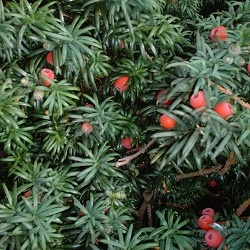| Taxaceae, Yew family | ||||||||||
|---|---|---|---|---|---|---|---|---|---|---|
| Scientific classification | ||||||||||
| ||||||||||
| Genera | ||||||||||
|
Taxaceae sensu stricto |
The Family Taxaceae, commonly called the yew family, includes three genera and about 7 to 10 species of coniferous plants, now generally included with all the other conifers in the Order Pinales. DNA analysis has shown that the yews are monophyletic with the other families in the Pinales (Chase et al., 1993; Price, 2003), a conclusion supported by micromorphological studies (Anderson & Owens, 2003). Formerly they were very often treated as distinct from other conifers and placed in a separate order: the Taxales.
These are much branched, small trees and shrubs with leaves alternate, 2-ranked, linear to lanceolate, and persistent (evergreen). The leaves have pale green or white stomatal bands on the undersides. Plants are dioecious, rarely monoecious, with a staminate strobilus (cone), and the ovule in a highly reduced cone with just one ovuliferous scale. As the seed matures, the ovuliferous scale develops into a fleshy aril partly enclosing the seed. The mature aril is brightly coloured, soft, juicy and sweet, and is eaten by birds which then disperse the hard seen undamaged in their droppings.
The genera Torreya and Amentotaxus, previously included in this family, are better transferred to the Cephalotaxaceae, to which DNA testing shows they are more closely related. Alternatively, Cephalotaxus may be included, together with these genera, in a broader interpretation of Taxaceae as a single larger family (Price, 2003). In this sense, the Taxaceae includes six genera and about 30 species. The Cephalotaxaceae differ from the Taxaceae in having larger seeds (over 10 mm long) which are completely enclosed in a fleshy aril, compared to small seeds (under 10 mm long) only partly enclosed in a fleshy aril in the Taxaceae.
Some botanists have transferred Austrotaxus to its own family, the Austrotaxaceae, suggesting it may be closer to the Podocarpaceae than to the other Taxaceae, but genetic evidence does not support this transfer.
References
- Anderson, E. & Owens, J. N. (2003). Analysing the reproductive biology of Taxus: should it be included in Coniferales? Acta Hort. 615: 233-234. (conclusion is 'yes')
- Chase, M. W. et al. (1993). Phylogenetics of seed plants, an analysis of nucleotide sequences from the plastid gene rbcL. Ann. Missouri Bot. Gard. 80: 528-580.
- Price, R. A. (2003). Generic and familial relationships of the Taxaceae from rbcL and matK sequence comparisons. Acta Hort. 615: 235-237.
Links to other Pinales
Pinaceae - Araucariaceae - Podocarpaceae - Sciadopityaceae - Cupressaceae - Cephalotaxaceae - Taxaceae
